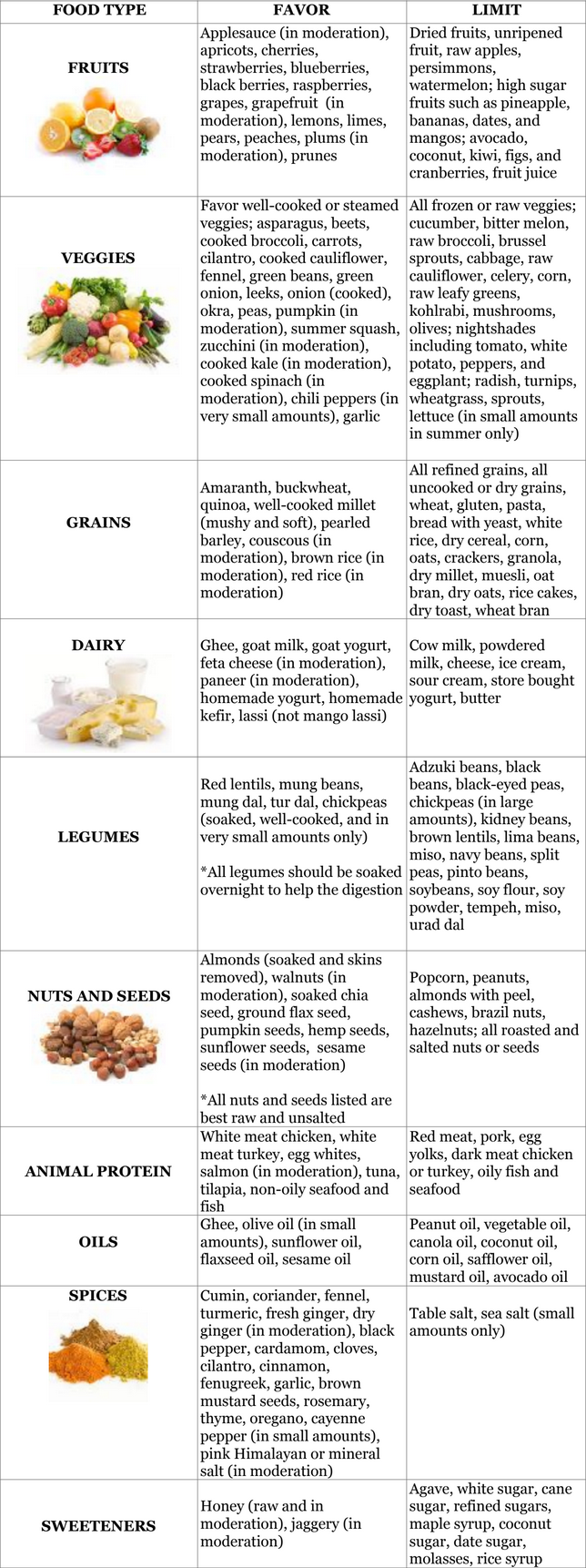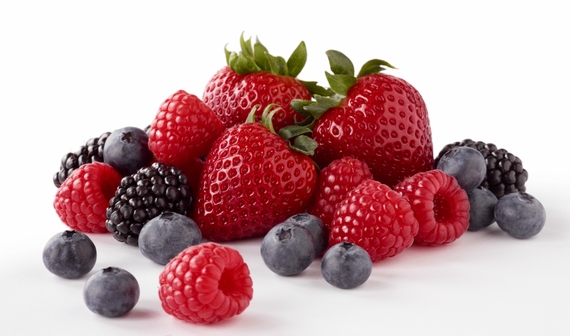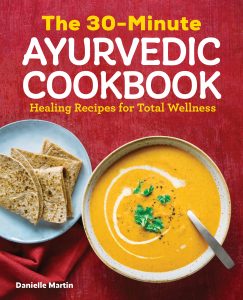 Ayurveda is based on the concept that we are all unique individuals with unique needs. Although there are 3 main body types (i.e. Vata, Pitta, Kapha) listed to help guide us on the best diet and lifestyle practices to keep us in balance, this can soon become confusing if you discover that you strongly resonate with more than one of these body-types. If your natural constitution is considered predominant in both Vata and Kapha; or you are a predominant Vata type with a Kapha imbalance; or a Kapha type with a Vata imbalance, keep reading to discover some dietary guidelines that will nourish and balance both of these “dueling” doshas.
Ayurveda is based on the concept that we are all unique individuals with unique needs. Although there are 3 main body types (i.e. Vata, Pitta, Kapha) listed to help guide us on the best diet and lifestyle practices to keep us in balance, this can soon become confusing if you discover that you strongly resonate with more than one of these body-types. If your natural constitution is considered predominant in both Vata and Kapha; or you are a predominant Vata type with a Kapha imbalance; or a Kapha type with a Vata imbalance, keep reading to discover some dietary guidelines that will nourish and balance both of these “dueling” doshas.
Since Vata and Kapha are fairly opposite in qualities, finding out the best foods for your needs may seem to be fairly complicated. For example, Vata is considered light, dry, mobile, and airy making heavy, oily, and grounding foods essential in a typical Vata-balancing diet. However, Kapha traits often include heavy, oily, slow, and dense and therefore any heavy, oily foods will surely increase Kapha dosha in the system, while light, drying foods (aka Vata-provoking foods) are said to be favored. Luckily there is some middle ground that can be established when dealing with these opposing forces to create balance and harmony between them.
When looking to bring balance to both Vata and Kapha, there are many foods that will work to calm both doshas. Since Vata and Kapha are both cool-cold by nature and often suffer from a weak digestive fire (although different areas of weakness), many foods, drinks, and spices that are heating to the body and stimulating to the digestion will be beneficial for both dosha types. Since Vata is light and dry by nature and Kapha is heavy and oily, any foods that are extremely light, drying, heavy, or oily should be avoided while favoring more neutral options instead.
Vata-Kapha Dietary Guidelines
Diet Do’s
- In general, you will want to follow a stricter Kapha-reducing diet in the winter and spring, and a stricter Vata-reducing diet in the fall.
- Eat on a healthy meal schedule: 6-8am: Light but fulfilling breakfast; 11am-1pm: hearty, healthy lunch; 6-7pm: small to medium-size dinner.
- Overall the food choices should be light, but nourishing with high amounts of lean, easy-to-digest protein (fish, chicken, egg whites, mung beans) and fiber (buckwheat, quinoa, cooked veggies, low sugar fruits); limit heavy or refined carbs (pasta, bread, wheat, gluten, white flour) and sugar (especially refined).
- Favor well-cooked, easy-to-digest meals such as soup, stews, crockpot dishes, porridges, dal, and kitchari.
- Favor low-sugar fruits such as berries, peaches, pears, apricots, and cherries; avoid fruit juice.
- Favor well-cooked or steamed veggies that are not too starchy such as carrots, okra, green beans, yellow squash, asparagus, zucchini, and peas.
- Favor lighter whole grains such as quinoa, buckwheat, well-cooked millet, and pearled barley.
- Favor lighter oils such as ghee, sunflower oil, and flax oil; sesame oil can be used in moderation.
- Favor honey (unheated) as a sweetener.
- Include lots of digestive spices in your meals such as fresh ginger, dry ginger, turmeric, fennel, coriander, cilantro, cardamom, and cumin.
- Dairy should be limited to ghee, homemade kefir, homemade yogurt, and goat dairy.
- Drink Ginger Tea or hot lemon water between meals to aid in digestion.
- Take Triphala Churna before bed each night to aid in digestion, elimination, and detoxification.
- When all else fails, find tridoshic foods, spices, drinks, and recipes for fool-proof options!
Dietary Don’ts
- Avoid all raw and cold foods.
- Avoid snacking in between meals.
- Avoid eating after 7pm (6pm in winter).
- Avoid iced and cold beverages.
- Avoid drinking fluids before, during, or directly after meals.
- Avoid dry, rough, old, and stale foods.
- Avoid heavy grains such as wheat, gluten, and oats.
- Avoid refined sugar, refined grains, processed food, additives, dyes, caffeine, alcohol, and tobacco.
- Avoid improper food combinations (read more here).
While adopting some of these beneficial dietary guidelines, you should also become familiar with the best foods to consume and which foods to limit or avoid. Please remember however, that these food charts are not all black and white. If you love a food on the “limit” list, you can likely enjoy it on occasion, especially if you are feeling in-balance. You can often “cheat” (with awareness and moderation) depending on the season and the context as well. For example, cashews are on the “limit” list, but if you want to add in a small handful to your quinoa and veggie stir fry instead of adding in a heavy protein, then the cashews will likely be a better choice. Therefore, use this chart as a guide and learn where you are able to intelligently play around on occasion.
Vata-Kapha Diet Chart
Click here for a printable version of this chart for your refrigerator!

Click here for a printable version of this chart for your refrigerator!
Recipes To Balance Vata and Kapha
- Sweet Potato Millet Porridge
- Golden Energy Buckwheat Breakfast
- Simply Spiced Quinoa Porridge
- Springtime Breakfast Scramble
- Spicy Dal and Peppered Rice
- Tridoshic Mung Dal and Quinoa Kitchari
- Classic Cleansing Kitchari
- Garlicky Golden Cauliflower Mashed Potatoes
- Spicy Spinach, Kale, And Cauliflower Curry
- Curried Coconut and Veggie Soup
- Savory Pumpkin Soup
- Healing Ayurvedic Bone Broth
- Simply Steamed Veggie Recipe
- The Essential Almond Milk
- Homemade Golden Almond Milk
- Extra-Potent Ginger Tea Infusion
- Hot Toddy Winter Tonic
- Tulsi, Ginger, Turmeric Tea
- Amazingly Addictive Homemade Hemp Milk
- Homemade Kefir in 5 Easy Steps
- Quick and Easy Homemade Ghee
Discover more amazing recipes with my 30-Minute Ayurvedic Cookbook!




Looking at the tongue I believe I am Kapha and vata imbalance. I read the foods to eat and not eat. Do you have to stick to this diet forever? Where do you buy the tea for herbal enema? How often do you do that?
Hi Denise,
Thank you for writing in with your questions! If you are a Kapha type, but have a Vata imbalance, it will be best to follow this diet until the Vata is healthy and stable. Once this happens, a more Kapha-specific diet will likely be more appropriate since this is your non-changing predominant dosha type. If your Vata is easily provoked however, the Kapha-Vata diet will likely be best until this is not the case since going to a strictly Kapha-pacifying diet can make the Vata high again if it is not completely stable.
As for the Dashamula herbal enema, this is a great treatment for Vata that will not provoke Kapha. How often you perform this will be according to your needs, but to begin you can try weekly for 4 weeks and then adjust the amounts as needed. You can purchase an herbal enema kit at this link here if you are interested.
I hope this helps. Please let me know if you have any further questions!
Namaste,
Danielle
Hello Danielle,
Thank you for this wonderful resource!
I have been told I am Vata – Kapha. I’ve been asked to follow a Kapha diet for the body and observe Vata lifestyle routines and habits for the mind by an ayurvedic doctor. Though for most of my adult life I was able to put on weight easily and had to watch my food for that reason, now in my mid 40’s I’m a few kilos underweight and struggling to put on some weight. So I’m curious if the Kapha diet is what I should be following..
I also live in a place where the summers are long and intense and I’ve read that the Vata Kapha diet must be altered to suit the seasons.
What would your advice be?
Hi Anusha,
Thank you for your question! Based on the information you have shared, I would say you may be needing more of a Vata-reducing diet. If there is Vata in the mind, and now it has increased in the body as well (due to the underweight issue), I would assume eating a lightening Kapha diet would not suit you at the moment. If you are finding yourself overheated, with your long, intense summers, a Vata-Pitta diet can be adopted until the cooler weather kicks in.
Please let me know if you have any further questions and I will be happy to help!
Namaste,
Danielle
Hi! I’m new to Ayurveda and I did a quiz and it told me I’m vatta-pitta with Kapha imbalance but I also think I have Vatta imbalance because I tend to be easily worried and anxious and I have a horrible dry mouth problem for some years now.
My tongue has been white and mapped as long as I can remember but also started getting ridges at the sides maybe 6 months ago.
I have always been constipated and very light sleeper since my teens.
I have never been able to lose belly fat except if I’m fat free raw vegan ( which I’m not able to keep up with emotionally as I miss the comfort of warm foods and some fats).
I also feel horrible eating fatty foods and get easily nauseas unless it’s sweet and fatty like cake, ice-cream or cookie. Oily salty foods make me very nauseas.
So I think I have both imbalances. Should I focus on vatta-kapha balancing as I think or just Kapha balancing? Thank you 🙏🌸
Hi Jarafel,
Thank you for sharing your story! There is very clear indication of Vata imbalance as well as Kapha, so you are correct to follow a Vata-Kapha diet. It can be tricky since they are so opposing to each other. I would use the recommendations in this article as guidelines but overall it will be important to listen to your body. If any food is making you nauseous, it is important to avoid it for now.
Since it sounds like your Agni (digestive fire) is weak, taking a digestive stimulant that is suitable for Vata and Kapha may be useful such as eating a slice of fresh ginger. I also suggest taking Triphala Churna before bed and drinking CCF tea between meals.
Many blessings,
Danielle